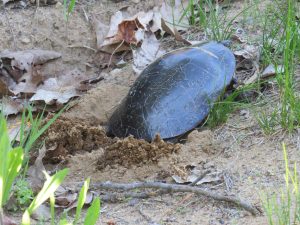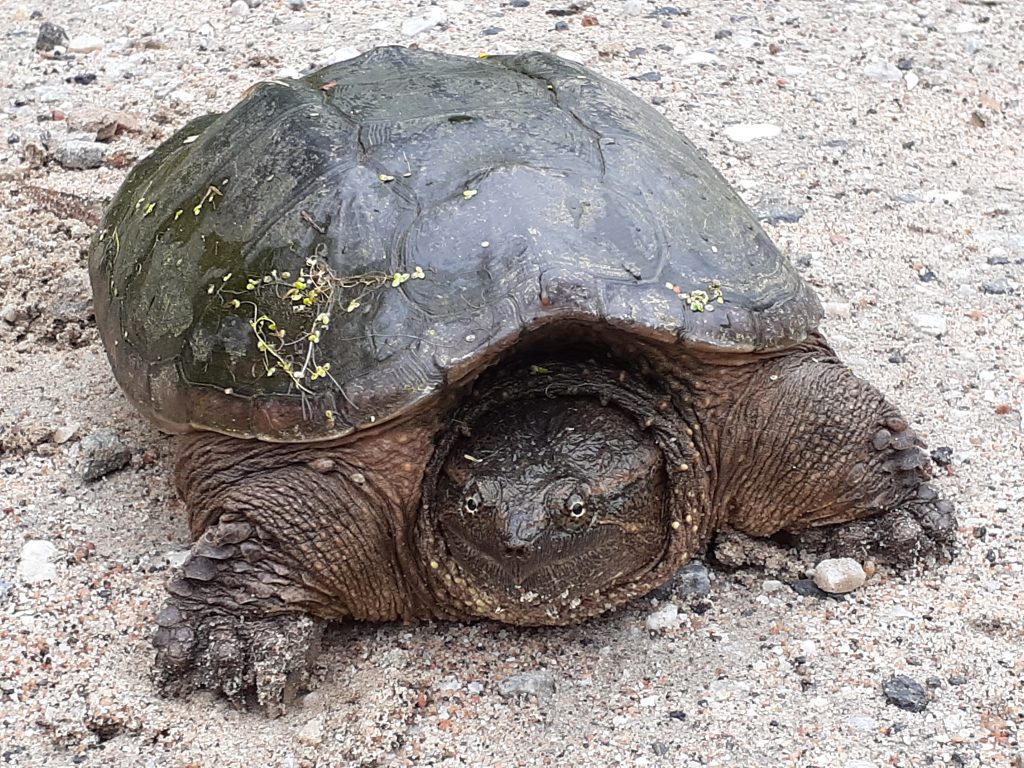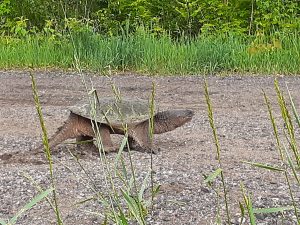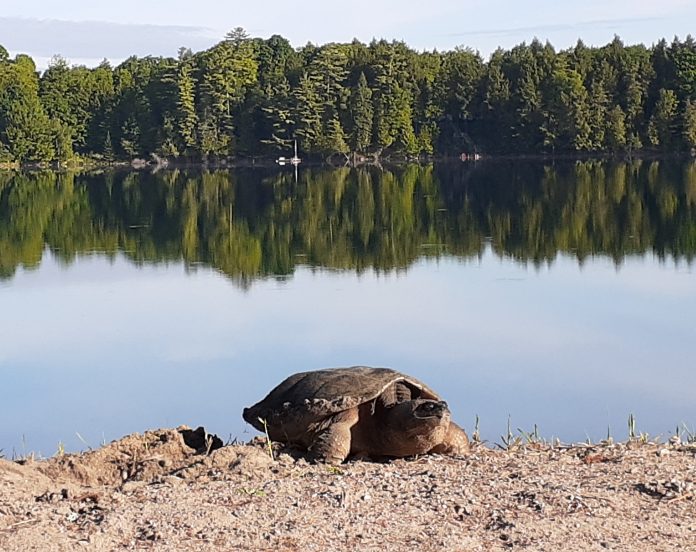Erratic weather patterns led to a slow start for Ontario’s turtle nesting season, but that hasn’t stopped the Ontario Turtle Hospital from receiving a record number of intakes.
Kelly Wallace, managing director and founder of the Think Turtle Conservation Initiative, said her team often starts around 5 a.m. and doesn’t finish until 8 to 10 p.m. The non-profit is based in Bancroft but provides turtle conservation education and assistance across the province. They split their days between answering phone calls, Facebook messages, and emails and doing work out in the field. Every day is different, but they’re often installing nest protectors and coordinating plans to rescue injured turtles. June is typically their busiest time, and this year is no exception despite the inconsistent temperatures.
“It’s got the turtles a bit mixed up because they’re so sensitive to environmental change,” Wallace said. “The snapping turtles, which are pretty much the most sensitive to the environmental change, they’re really just starting to get nesting.”
Every year, turtle conservationists across the province try to plan for the busy season, but it all comes down to the transition between winter and spring, Wallace said. The change between seasons dictates the reproduction timeline, and it’s always different.

Her team has seen a lot of digging and other activity from snapping turtles, but they haven’t fully settled into nesting. Looking at the weather forecast, a cooler end to June and high temperatures in July are a good indication that most nesting activity will happen over the next few weeks, taper off during cooler temperatures, and pick back up in July.
Climate change has impacted turtle habits in a few ways. One of those is the increased tendency to overwinter in their nests. Turtle hatchlings will remain in an underground nest throughout the winter before emerging from April to early June. The Think Turtle team saw one emerge at the end of last week. It’s yet another testament to this year’s unusual weather patterns, and the heat anticipated next month is expected to have its own effects.
“If we’re going to have a really, really hot summer, then that means that we probably are going to end up having more female hatchlings because the sex is dependent on the temperature,” she said. “There’s more females when it’s hot and then when it’s cooler, there’s more males.”
The same is true in each individual nest. The eggs at the top of the nest that get more sunlight are more likely to be females. In the middle of the nest, it will be a mix of sexes while the eggs toward the bottom are more likely to be male.
Despite the many effects of climate change, one thing has stayed consistent: getting struck by a vehicle remains one of the greatest threats to Ontario’s turtles. As of June 11, the number of intakes at the turtle hospital was 1,128, double what they had at the same time last year. It’s a significant increase that’s both good and bad; the number of injured turtles is shocking, but they’re getting better care than ever before.
One of the biggest things members of the public can do is simply watch the road and surrounding areas for turtles and other wildlife. Road mortality is a major contributor to population decline in turtles and other animals, so though Ontario is lucky to have a turtle hospital, it’s better to reduce the need for their services, especially when it comes to avoidable injuries on the road.
“It’s one of those things where it’s really jarring to think of that many turtles being largely hit by vehicles, but also, it is remarkable the number of people that are helping and stopping and making sure that the turtles get to the turtle hospital,” she said.

For people who want to get more involved in turtle conservation, there are a range of ways to help. People with nests on their property can install nest protectors. Nest protectors are available for purchase across the province and Think Turtle offers instructions on how property owners can make their own.
The Ontario Turtle Conservation Centre (OTCC), home to the turtle hospital in Peterborough, has a network of volunteers called turtle taxi drivers. The drivers help coordinate travel for injured turtles to ensure they receive timely medical attention. Long-distance trips can be split up by multiple volunteers, so volunteers in areas like Muskoka can be a valuable asset.
Another great way to help is by assisting turtles across the road when it’s safe to do so. It’s important to move turtles in the direction they’re already headed; otherwise, they’re likely to double back and cross the road again. When handling turtles, people should wear gloves, hold the turtle low to the ground to avoid damage to their shells if they’re dropped, and never hold turtles by their tails.
Smaller turtles can be picked up by the middle of their shell, but since snappers have such long necks, they should be handled from the back of their shell. Volunteers can either slide their hand under the back of the turtle like a pizza box, put their hands on either side of the tail to lift, or use a shovel to move the animal.
Locals can help with data collection by reporting turtle sightings in the Simcoe-Muskoka region to the Saving Turtles At Risk Today (S.T.A.R.T.) Turtle Project at 705-955-4284. They take calls for sightings of rare species or nesting females as well as injured or dead turtles. People can also call the OTCC at 705-741-5000 to report injured turtles.
“When people stop to help an injured turtle and they report it to the turtle hospital, they should make sure that they do that when they’re with the turtle,” Wallace said. “Because once you drive away from the turtle, if it’s injured and if it does actually manage to be mobile enough that they can get back into the wild, the chances of it surviving without medical care, it’s very debatable.”

Remaining at the site gives turtle taxi drivers and other volunteers the best possible opportunity to locate and secure injured turtles. Soon, the turtles may not have to travel so far.
The S.T.A.R.T. Turtle Project collaborates with the Georgian Bay Turtle Hospital. They’re not ready to provide rehabilitative services yet, but they hope to become the second designated turtle hospital in the province to expand options for treatment and to reduce the environmental impact of transporting injured turtles.
While it’s devastating to see so many injured animals, Wallace said Ontario is lucky to have the resources it does. She started working in turtle conservation in 2016 and founded Think Turtle two years later. In the years since she started, she’s seen a dramatic increase in the number of people who are interested in turtle conservation.
She said more people are talking about turtles and nature as a whole, so it’s been amazing to see the shift. She’s glad that more and more people are mindful of their time on the road and willing to help turtles along the way, particularly considering the toll humans have taken on their territory.
“We built the roads and basically we fragmented their habitat and their natural corridors,” she said. “We get to hear more and more about people that are stopping safely to help move turtles in the direction they were headed, and that right there, that’s a citizen-based conservation effort that makes such a huge difference.”
For more information about turtle conservation, visit the Think Turtle Conservation Initiative online.








